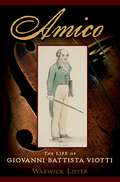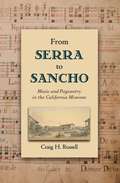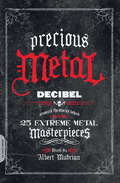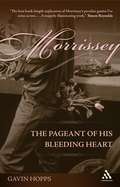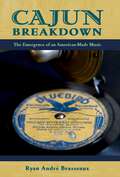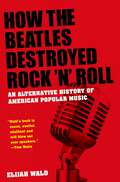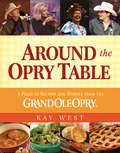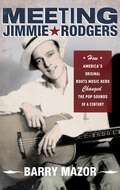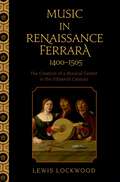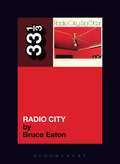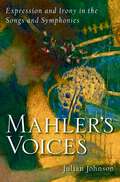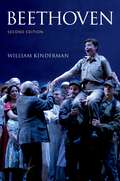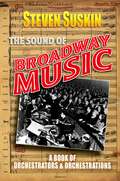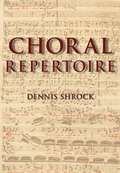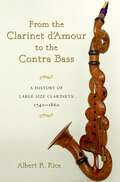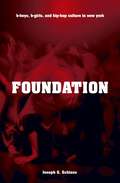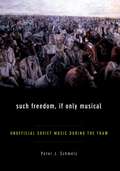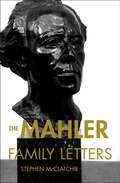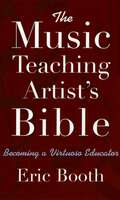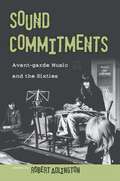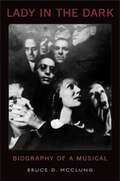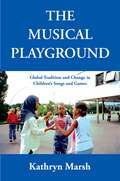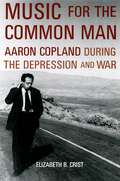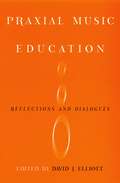- Table View
- List View
Amico: The Life of Giovanni Battista Viotti
by Warwick ListerThis is the first full-length biography in English of Giovanni Battista Viotti (1755-1824), one of the great violinist-composers in the history of music, and arguably the most influential violinist who ever lived. This study is based on extensive documentary research, much of it here revealed for the first time.
From Serra to Sancho: Music and Pageantry in the California Missions (Currents in Latin American and Iberian Music)
by Craig H. RussellMusic in the California missions was a pluralistic combination of voices and instruments, of liturgy and spectacle, of styles and functions--and even of cultures--in a new blend that was non-existent before the Franciscan friars made their way to California beginning in 1769. From Serra to Sancho explores the exquisite sacred music that flourished on the West Coast of the United States when it was under Spanish and Mexican rule, delving into the historical, cultural, biographical, and stylistic aspects of California mission music during the late eighteenth and early nineteenth centuries. Author Craig H. Russell examines how mellifluous plainchant, reverent hymns, spunky folkloric ditties, "classical" music in the style of Haydn, and even Native American drumming were interwoven into a tapestry of resonant beauty. In addition to extensive musical and cultural analysis, Russell draws upon hundreds of primary documents in California, Mexico, Madrid, Barcelona, London, and Mallorca. It is through the melding together of this information from geographically separated places that he brings the mystery of California's mission music into sharper focus. Russell's groundbreaking study sheds new light on the cultural exchange that took place in the colonial United States, as well as on the pervasive worldwide influence of Iberian music as a whole.
Precious Metal: Decibel Presents the Stories Behind 25 Extreme Metal Masterpieces
by Albert MudrianDecibel magazine is regarded as the best extreme music magazine around.Precious Metal gathers pieces from Decibel's most popular feature, the monthly &“Hall of Fame&” which documents the making of landmark metal albums via candid, hilarious, and fascinating interviews with every participating band member.Decibel's editor-in-chief Albert Mudrian, has selected and expanded the best of these features, creating a definitive collection of stories behind the greatest extreme metal albums of all time.
Morrissey: The Pageant of His Bleeding Heart
by Gavin HoppsMorrissey is arguably the greatest disturbance popular music has ever known. Even more than the choreographed carelessness of punk and the hyperbolic gestures of glam rock and the New Romantics, Morrissey's early bookish ineptitude, his celebration of the ordinary, and his subversive endorsement of celibacy, abstinence and rock 'n' roll revolutionized the world of British pop. As a solo artist, too, he consistently adopts the outsider's perspective and dares us to confront uncomfortable subjects. In his brilliant book, Gavin Hopps examines the work of this compelling performer, whose intelligence, humour, suffering and awkwardness have fascinated audiences around the world for the last 25 years.Hopps traces the trajectory of Morrissey's career and outlines the contours and contradictions of the singer's elusive persona. The book illuminates Morrissey's coyness (how can he remain a mystery when he tells us too much?), his dramatized melancholy (surely more of a radical existential protest than the gimmick some believe it to be), and his complex attitudes towards loneliness and alienation, as well as his intriguing sense of the religious.
Cajun Breakdown: The Emergence of an American-Made Music (American Musicspheres)
by Ryan Andre BrasseauxIn 1946, Harry Choates, a Cajun fiddle virtuoso, changed the course of American musical history when his recording of the so-called Cajun national anthem "Jole Blon" reached number four on the national Billboard charts. Cajun music became part of the American consciousness for the first time thanks to the unprecedented success of this issue, as the French tune crossed cultural, ethnic, racial, and socio-economic boundaries. Country music stars Moon Mullican, Roy Acuff, Bob Wills, and Hank Snow rushed into the studio to record their own interpretations of the waltz-followed years later by Waylon Jennings and Bruce Springsteen. The cross-cultural musical legacy of this plaintive waltz also paved the way for Hank Williams Sr.'s Cajun-influenced hit "Jamabalaya." Choates' "Jole Blon" represents the culmination of a centuries-old dialogue between the Cajun community and the rest of America. Joining into this dialogue is the most thoroughly researched and broadly conceived history of Cajun music yet published, Cajun Breakdown. Furthermore, the book examines the social and cultural roots of Cajun music's development through 1950 by raising broad questions about the ethnic experience in America and nature of indigenous American music. Since its inception, the Cajun community constantly refashioned influences from the American musical landscape despite the pressures of marginalization, denigration, and poverty. European and North American French songs, minstrel tunes, blues, jazz, hillbilly, Tin Pan Alley melodies, and western swing all became part of the Cajun musical equation. The idiom's synthetic nature suggests an extensive and intensive dialogue with popular culture, extinguishing the myth that Cajuns were an isolated folk group astray in the American South. Ryan André Brasseaux's work constitutes a bold and innovative exploration of a forgotten chapter in America's musical odyssey.
How the Beatles Destroyed Rock 'n' Roll: An Alternative History of American Popular Music
by Elijah Wald"There are no definitive histories," writes Elijah Wald, in this provocative reassessment of American popular music, "because the past keeps looking different as the present changes." Earlier musical styles sound different to us today because we hear them through the musical filter of other styles that came after them, all the way through funk and hip hop. As its blasphemous title suggests, How the Beatles Destroyed Rock 'n' Roll rejects the conventional pieties of mainstream jazz and rock history. Rather than concentrating on those traditionally favored styles, the book traces the evolution of popular music through developing tastes, trends and technologies--including the role of records, radio, jukeboxes and television --to give a fuller, more balanced account of the broad variety of music that captivated listeners over the course of the twentieth century. Wald revisits original sources--recordings, period articles, memoirs, and interviews--to highlight how music was actually heard and experienced over the years. And in a refreshing departure from more typical histories, he focuses on the world of working musicians and ordinary listeners rather than stars and specialists. He looks for example at the evolution of jazz as dance music, and rock 'n' roll through the eyes of the screaming, twisting teenage girls who made up the bulk of its early audience. Duke Ellington, Benny Goodman, Frank Sinatra, Elvis Presley, Chuck Berry, and the Beatles are all here, but Wald also discusses less familiar names like Paul Whiteman, Guy Lombardo, Mitch Miller, Jo Stafford, Frankie Avalon, and the Shirelles, who in some cases were far more popular than those bright stars we all know today, and who more accurately represent the mainstream of their times. Written with verve and style, How the Beatles Destroyed Rock 'n' Roll shakes up our staid notions of music history and helps us hear American popular music with new ears.
Around the Opry Table: A Feast of Recipes and Stories from the Grand Ole Opry
by Kay WestCountry music and country cooking fans everywhere will savor this new official cookbook of the Grand Ole Opry and its members, featuring favorite recipes of country music legends past and present and the stories behind them.
Meeting Jimmie Rodgers: How America's Original Roots Music Hero Changed the Pop Sounds of a Century
by Barry MazorIn Meeting Jimmie Rodgers, the first book to explore the deep legacy of "The Singing Brakeman" from a twenty-first century perspective, Barry Mazor offers a lively look at Rodgers' career, tracing his rise from working-class obscurity to the pinnacle of renown that came with such hits as "Blue Yodel" and "In the Jailhouse Now." As Mazor shows, Rodgers brought emotional clarity and a unique sense of narrative drama to every song he performed, whether tough or sentimental, comic or sad. His wistful singing, falsetto yodels, bold flat-picking guitar style, and sometimes censorable themes--sex, crime, and other edgy topics--set him apart from most of his contemporaries. But more than anything else, Mazor suggests, it was Rodgers' shape-shifting ability to assume many public personas--working stiff, decked-out cowboy, suave ladies' man--that connected him to such a broad public and set the stage for the stars who followed him. In reconstructing this far-flung legacy, Mazor enables readers to meet Rodgers and his music anew-not as an historical figure, but as a vibrant, immediate force.
Music in Renaissance Ferrara 1400-1505: The Creation of a Musical Center in the Fifteenth Century
by Lewis LockwoodBased on extensive documentary and archival research, Music in Renaissance Ferrara is a documentary history of music for one of the most important city-states of the Italian Renaissance. Lockwood shows how patrons and musicians created a musical center over the course of the fifteenth-century, tracing the growth of music and musical life in rich detail. It also sheds new light on the careers of such important composers as Dufay, Martini, Obrecht, and Josquin Desprez. This paperback edition features a new preface that re-introduces the book and reflects on its contribution to our modern knowledge of music in the culture of the Italian Renaissance.
Big Star's Radio City (33 1/3)
by Bruce EatonReleased when ELP and Elton John were plodding from one packed stadium to the next, Radio City was a radical album influenced by records that were already deemed oldies and yet sounding like a lean electrical jolt from the future. Here, Bruce Eaton examines the key ingredients of Radio City's lasting appeal- and through extensive interviews with all of those involved, gets to the heart of the cult of Big Star.
Mahler's Voices: Expression and Irony in the Songs and Symphonies
by Julian JohnsonMahler's Voices brings together a close reading of the renowned composer's music with wide-ranging cultural and historical interpretation, unique in being a study not of Mahler's works as such but of Mahler's musical style.
Mahler's Voices: Expression and Irony in the Songs and Symphonies
by Julian JohnsonMahler's Voices brings together a close reading of the renowned composer's music with wide-ranging cultural and historical interpretation, unique in being a study not of Mahler's works as such but of Mahler's musical style.
Beethoven
by William KindermanCombining musical insight with the most recent research, William Kinderman's Beethoven is both a richly drawn portrait of the man and a guide to his music. Kinderman traces the composer's intellectual and musical development from the early works written in Bonn to the Ninth Symphony and the late quartets, looking at compositions from different and original perspectives that show Beethoven's art as a union of sensuous and rational, of expression and structure. In analyses of individual pieces, Kinderman shows that the deepening of Beethoven's musical thought was a continuous process over decades of his life. In this new updated edition, Kinderman gives more attention to the composer's early chamber music, his songs, his opera Fidelio, and to a number of often-neglected works of the composer's later years and fascinating projects left incomplete. A revised view emerges from this of Beethoven's aesthetics and the musical meaning of his works. Rather than the conventional image of a heroic and tormented figure, Kinderman provides a more complex, more fully rounded account of the composer. Although Beethoven's deafness and his other personal crises are addressed, together with this ever-increasing commitment to his art, so too are the lighter aspects of his personality: his humor, his love of puns, his great delight in juxtaposing the exalted and the commonplace.
The Sound of Broadway Music: A Book of Orchestrators and Orchestrations
by Steven SuskinBroadway's top orchestrators - Robert Russell Bennett, Don Walker, Philip J. Lang, Jonathan Tunick - are names well known to musical theatre fans, but few people understand precisely what the orchestrator does. The Sound of Broadway Music is the first book ever written about these unsung stars of the Broadway musical whose work is so vital to each show's success. The book examines the careers of Broadway's major orchestrators and follows the song as it travels from the composer's piano to the orchestra pit. Steven Suskin has meticulously tracked down thousands of original orchestral scores, piecing together enigmatic notes and notations with long-forgotten documents and current interviews with dozens of composers, producers, conductors and arrangers. The information is separated into three main parts: a biographical section which gives a sense of the life and world of twelve major theatre orchestrators, as well as incorporating briefer sections on another thirty arrangers and conductors; a lively discussion of the art of orchestration, written for musical theatre enthusiasts (including those who do not read music); a biographical section which gives a sense of the life and world of twelve major theatre orchestrators, as well as incorporating briefer sections on another thirty arrangers and conductors; and an impressive show-by-show listing of more than seven hundred musicals, in many cases including a song-by-song listing of precisely who orchestrated what along with relevant comments from people involved with the productions. Stocked with intriguing facts and juicy anecdotes, many of which have never before appeared in print, The Sound of Broadway Music brings fascinating and often surprising new insight into the world of musical theatre.
Choral Repertoire
by Dennis ShrockChoral Repertoire is the definitive and comprehensive one-volume presentation of the canon of the Western choral tradition. Designed for practicing conductors and directors, students and teachers of choral music, amateur and professional singers, scholars, and interested vocal enthusiasts, it is an account of the complete choral output of the most significant composers of this genre throughout history. Organized by era (Medieval, Renaissance, Baroque, Classical, Romantic, and Modern), Choral Repertoire covers general characteristics of each historical era; trends and styles unique to various countries; biographical sketches of over 500 composers; and performance annotations of more than 5,000 individual works. This book will be an essential guide to programming, a reference tool for program notes and other research, and, most importantly, a key resource for conductors, instructors, scholars, and students of choral music.
From the Clarinet D'Amour to the Contra Bass: A History of Large Size Clarinets, 1740-1860
by Albert R. RiceFollowing his much-acclaimed The Baroque Clarinet and The Clarinet in the Classical Period, Albert R. Rice now turns his signature detailed attention to large clarinets - the clarinet d'amour, the basset horn, the alto clarinet, bass and contra bass clarinets. Each chapter is devoted to a specific instrument, and offers a fascinating insider's look at its defining characteristics, a comprehensive history of its evolution, meticulously-researched information on its makers and aspects of construction, and a thorough discussion of its music. Rice illustrates how the introduction of large clarinets into chamber ensembles, wind bands, and opera orchestras was the result of experiments meant to address specific musical needs. Along the way, he brings to life the musicians, virtuosi, soloists, and orchestral and band musicians, as well as the instruments' makers and the composers from J. C. Bach to Smetana who wrote for them. Based on careful study of primary sources - musical compositions, patents, memoirs and diaries, and unfettered access to historical instruments themselves--Rice's expert presentation is nothing short of exhaustive. From the Clarinet d'Amour to the Contrabass will engage all who love the clarinet and its music.
Foundation: B-boys, B-girls and Hip-Hop Culture in New York
by Joseph G. SchlossB-boying is a form of Afro-diasporic competitive dance that developed in the Bronx, NY in the early 1970s. Widely - though incorrectly - known as "breakdancing," it is often dismissed as a form of urban acrobatics set to music. In reality, however, b-boying is a deeply traditional and profoundly expressive art form that has been passed down from teacher to student for almost four decades. Foundation: B-boys, B-girls and Hip-Hop Culture in New York offers the first serious study of b-boying as both unique dance form and a manifestation of the most fundamental principles of hip-hop culture. Drawing on anthropological and historical research, interviews and personal experience as a student of the dance, Joseph Schloss presents a nuanced picture of b-boying and its social context. From the dance's distinctive musical repertoire and traditional educational approaches to its complex stylistic principles and secret battle strategies, Foundation illuminates a previously unexamined thread in the complex tapestry that is contemporary hip-hop.
Such Freedom, If Only Musical: Unofficial Soviet Music During the Thaw
by Peter J SchmelzFollowing Stalin's death in 1953, during the period now known as the Thaw, Nikita Khrushchev opened up greater freedoms in cultural and intellectual life. A broad group of intellectuals and artists in Soviet Russia were able to take advantage of this, and in no realm of the arts was this perhaps more true than in music. Students at Soviet conservatories were at last able to use various channels--many of questionable legality--to acquire and hear music that had previously been forbidden, and visiting performers and composers brought young Soviets new sounds and new compositions. In the 1960s, composers such as Andrey Volkonsky, Edison Denisov, Alfred Schnittke, Arvo Pärt, Sofia Gubaidulina, and Valentin Silvestrov experimented with a wide variety of then new and unfamiliar techniques ranging from serialism to aleatory devices, and audiences eager to escape the music of predictable sameness typical to socialist realism were attracted to performances of their new and unfamiliar creations. This "unofficial" music by young Soviet composers inhabited the gray space between legal and illegal. Such Freedom, If Only Musical traces the changing compositional styles and politically charged reception of this music, and brings to life the paradoxical freedoms and sense of resistance or opposition that it suggested to Soviet listeners. Author Peter J. Schmelz draws upon interviews conducted with many of the most important composers and performers of the musical Thaw, and supplements this first-hand testimony with careful archival research and detailed musical analyses. The first book to explore this period in detail, Such Freedom, If Only Musical will appeal to musicologists and theorists interested in post-war arts movements, the Cold War, and Soviet music, as well as historians of Russian culture and society.
The Mahler Family Letters
Hundreds of the letters that Gustav Mahler addressed to his parents and siblings survive, yet they have remained virtually unknown. Now, for the first time Mahler scholar Stephen McClatchie presents over 500 of these letters in a clear, lively translation in The Mahler Family Letters . Drawn primarily from the Mahler-Rose Collection at the University of Western Ontario, the volume presents a complete, well-rounded view of the family's correspondence. Spanning the mid 1880s through 1910, the letters record the excitement of a young man with a bourgeoning career as a conductor and provide a glimpse into his day-to-day activities rehearsing and conducting operas and concerts in Budapeast and Hamburg, and composing his first symphonies and songs. On the private side, they document his parents' illnesses and deaths and the struggles of his siblings Alois, Justine, Otto, and Emma. The letters also give Mahler's insightful impressions of contemporaries such as Johannes Brahms, Richard Strauss, and Hans von Bulow, as well as his personal feelings about significant events, such as his first big success--the completion of Carl Maria von Weber's Die drei Pintos in 1889. In the fall of 1894, the character of the letters changes when Justine and Emma come to live with Mahler in Hamburg and then Vienna, removing the need to communicate by letter about quotidian matters. At this point, the letters relay noteworthy events such as Mahler's campaign to be named Director of the Vienna Court Opera, his conducting tours throughout Europe, and his courtship of Alma Schindler. The Mahler Family Letters provides a vital, nuanced source of information about Mahler's life, his personality, and his relationships. McClatchie has generously annotated each letter, contextualizing and clarifying contemporary historical references and Mahler family acquaintances, and created an indispensable resource for all Mahlerists, 19th-century musicologists, and historians of 19th-century Germany and Austria.
The Music Teaching Artist's Bible: Becoming a Virtuoso Educator
by Eric BoothWhen the artist moves into the classroom or community to educate and inspire students and audience members, this is Teaching Artistry. It is a proven means for practicing professional musicians to create a successful career in music, providing not only necessary income but deep and lasting satisfaction through engaging people in learning experiences about the arts. Filled with practical advice on the most critical issues facing the music teaching artist today--from economic and time-management issues of being a musician and teacher to communicating effectively with students--The Music Teaching Artist's Bible uncovers the essentials that every musician needs in order to thrive in this role. Author Eric Booth offers both inspiration and how-to, step-by-step guidance in this truly comprehensive manual that music teaching artists will turn to again and again. The book also includes critical information on becoming a mentor, succeeding in school environments, partnering with other teaching artists, advocating for music and arts education, and teaching private lessons. The Music Teaching Artist's Bible helps practicing and aspiring teaching artists gain the skills they need to build new audiences, improve the presence of music in schools, expand the possibilities of traditional and educational performances, and ultimately make their lives as an artists even more satisfying and fulfilling.
Sound Commitments: Avant-Garde Music and the Sixties
by Robert AdlingtonThe role of popular music is widely recognized in giving voice to radical political views, the plight of the oppressed, and the desire for social change. Avant-garde music, by contrast, is often thought to prioritize the pursuit of new technical or conceptual territory over issues of human and social concern. Yet throughout the activist 1960s, many avant-garde musicians were convinced that aesthetic experiment and social progressiveness made natural bedfellows. Intensely involved in the era's social and political upheavals, they often sought to reflect this engagement in their music. Yet how could avant-garde musicians make a meaningful contribution to social change if their music remained the preserve of a tiny, initiated clique? In answer, Sound Commitments, examines the encounter of avant-garde music and "the Sixties" across a range of genres, aesthetic positions and geographical locations. Through music for the concert hall, tape and electronic music, jazz and improvisation, participatory "events," performance art, and experimental popular music, the essays in this volume explore developments in the United States, France, West Germany, Italy, the Netherlands, the Soviet Union, Japan and parts of the "Third World," delving into the deep richness of avant-garde musicians' response to the decade's defining cultural shifts. Featuring new archival research and/or interviews with significant figures of the period in each chapter, Sound Commitments will appeal to researchers and advanced students in the fields of post-war music, cultures of the 1960s, and the avant-garde, as well as to an informed general readership.
Lady in the Dark: Biography of a Musical
by Bruce D. McclungWhen Lady in the Dark opened on January 23, 1941, its many firsts immediately distinguished it as a new and unusual work. The curious directive to playwright Moss Hart to complete a play about psychoanalysis came from his own Freudian psychiatrist. For the first time since his brother George's death, Ira Gershwin returned to writing lyrics for the theater. And for émigré composer Kurt Weill, it was a crack at an opulent first-class production. Together Hart, Gershwin, and Weill (with a little help from the psychiatrist) produced one of the most innovative works in Broadway history. With a company of 101 and an astronomical budget, Lady in the Dark launched the career of a young nightclub performer named Danny Kaye and starred Gertrude Lawrence in the greatest triumph of her career. With standees at many performances, Lady in the Dark helped establish the practice of advance ticket sales on the Great White Way, while Paramount Pictures' bid for the film rights broke all records. New York Times drama critic Brooks Atkinson hailed the production as "splendid," anointed Kurt Weill 'the best writer of theatre music in the country,' and worshiped Gertrude Lawrence as "a goddess." Though Lady in the Dark was a smash-hit, it has never enjoyed a Broadway revival, and a certain mystique has grown up around its legendary original production. In this ground-breaking biography, bruce mcclung pieces together the musical's life story from sketches and drafts, production scripts, correspondence, photographs, costume and set designs, and thousands of clippings from the star's personal scrapbooks. He has interviewed eleven members of the original company to provide a one-of-a-kind glimpse into the backstage story. The result is a virtual ticket to opening night, the saga of how this musical play came to be, and the string of events that saved the experimental show at every turn. Although America was turned upside down by Pearl Harbor after the production was on the boards, Lady in the Dark played an important role for the war effort and rang up 777 performances in 12 cities. In what may be the most illuminating study of a single Broadway musical, this biography brings Lady in the Dark back to the spotlight and puts readers in the front row.
The Musical Playground: Global Tradition and Change in Children's Songs and Games
by Kathryn MarshThe Musical Playground is a new and fascinating account of the musical play of school-aged children. Based on fifteen years of ethnomusicological field research in urban and rural school playgrounds around the globe, Kathryn Marsh provides unique insights into children's musical playground activities across a comprehensive scope of social, cultural, and national contexts. With a sophisticated synthesis of ethnomusicological and music education approaches, Marsh examines sung and chanted games, singing and dance routines associated with popular music and sports chants, and more improvised and spontaneous chants, taunts, and rhythmic movements. The book's index of more than 300 game genres is a valuable reference to readers in the field of children's folklore, providing a unique map of game distribution across an array of cultures and geographical locations. On the companion website, readers will be able to view on streamed video, field recordings of children's musical play throughout the wide range of locations and cultures that form the core of Marsh's study, allowing them to better understand the music, movement, and textual characteristics of musical games and interactions. Copious notated musical examples throughout the book and the website demonstrate characteristics of game genres, children's generative practices, and reflections of cultural influences on game practice, and valuable, practical recommendations are made for developing pedagogies which reflect more child-centred and less Eurocentric views of children's play, musical learning, and musical creativity. Marsh brings readers to playgrounds in Australia, Norway, the USA, the United Kingdom, and Korea, offering them an important and innovative study of how children transmit, maintain, and transform the games of the playground. The Musical Playground will appeal to practitioners and researchers in music education, ethnomusicology, and folklore.
Music for the Common Man: Aaron Copland during the Depression and War
by Elizabeth B. CristIn the 1930s, Aaron Copland began to write in an accessible style he described as "imposed simplicity." Works like El Salón México, Billy the Kid, Lincoln Portrait, and Appalachian Spring feature a tuneful idiom that brought the composer unprecedented popular success and came to define an American sound. Yet the cultural substance of that sound--the social and political perspective that might be heard within these familiar pieces--has until now been largely overlooked. While it has long been acknowledged that Copland subscribed to leftwing ideals, Music for the Common Man is the first sustained attempt to understand some of Copland's best-known music in the context of leftwing social, political, and cultural currents of the Great Depression and Second World War. Musicologist Elizabeth Crist argues that Copland's politics never merely accorded with mainstream New Deal liberalism, wartime patriotism, and Communist Party aesthetic policy, but advanced a progressive vision of American society and culture. Copland's music can be heard to accord with the political tenets of progressivism in the 1930s and '40s, including a fundamental sensitivity toward those less fortunate, support of multiethnic pluralism, belief in social democracy, and faith that America's past could be put in service of a better future. Crist explores how his works wrestle with the political complexities and cultural contradictions of the era by investing symbols of America--the West, folk song, patriotism, or the people--with progressive social ideals. Much as been written on the relationship between politics and art in the 1930s and '40s, but very little on concert music of the era. Music for the Common Man offers fresh insights on familiar pieces and the political context in which they emerged.
Praxial Music Education: Reflections and Dialogues
Praxial Music Education is a collection of essays by nineteen internationally recognized scholars in music education. Each essay offers critical reflections on a key topic in contemporary music education. The starting point of each essay, and the unifying thread of this collection, is the "praxial" philosophy of music education explained in Elliott's Music Matters: A New Philosophy of Music Education (OUP, 1995). This philosophy argues for a socially and artistically grounded concept of music and music education, challenging the field's traditional "absolutist" foundations. Praxial Music Education is both a critical companion to Music Matters, and an independent text on contemporary issues in music education. Among the themes discussed are multicultural music education, the nature of musical understanding, early childhood music education, the nature and teaching of music listening, music curriculum development, and musical creativity. Praxial music education is a living theory. This unique collection will not only enrich discussions that already use Music Matters as their core, but will globalize current discussions and applications of the praxial philosophy and emphasize the positive and practical values of collaborative efforts in music education.
